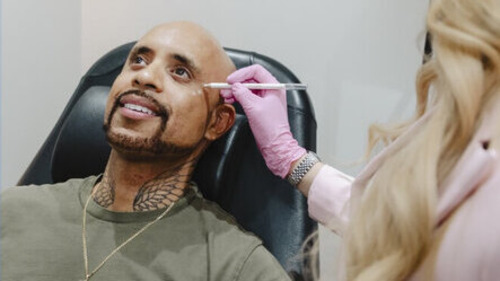Scars can leave lasting changes in skin texture and tone that are often difficult to address with topical skincare alone. Fortunately, advanced treatments like microneedling can help minimise scarring by stimulating the skin’s natural repair processes. In this article, we cover the benefits of microneedling, who it’s best suited for and potential risks to watch out for.
What is microneedling?
Microneedling, or skin needling, is a minimally invasive treatment that utilises fine, medical-grade needles to create thousands of controlled microchannels onto the skin’s surface. These tiny punctures stimulate the body’s natural healing response, encouraging the creation of collagen and elastin — the building blocks of firm, resilient skin.
Microneedling for scars — a targeted approach to smoother skin
Scars can develop from blemishes, injury or surgery when the skin’s natural repair process creates uneven tissue. Microneedling can be used as part of a targeted plan to minimise scarring by breaking down existing scar tissue and promoting the renewal of healthy skin cells. Another benefit of microneedling is that it prompts collagen production in the treated areas, potentially improving overall skin texture and elasticity.
Microneedling for scars is tailored to your specific skin and the type of scarring being treated. Needle depth, treatment intensity and session timing are carefully adjusted to ensure the approach aligns with your needs and goals. Results of this treatment may also vary depending on various factors such as skin type, the severity and age of scars, overall skin health and how well aftercare instructions are followed.
Ideal candidates for microneedling
Microneedling is well-suited to individuals who wish to address mild to moderate scarring, uneven texture or early signs of ageing. The most suitable candidates are in good overall health, have realistic expectations about outcomes and are committed to following proper aftercare.
Certain conditions or situations may mean microneedling should be delayed or avoided. These include:
- Active skin infections like herpes simplex or impetigo, which should be fully treated before undergoing the treatment.
- Blood disorders that affect clotting or the use of anticoagulant medication, which can increase the risk of complications.
- Pregnancy, as the safety of microneedling during this time has not been established. It may be best to wait until after childbirth.
- History of keloid scarring, as this may increase the likelihood of developing new or worsened scars following the treatment.
Potential risks and side effects of skin needling
Like any cosmetic treatment, microneedling carries possible risks and side effects. Most are mild and temporary, such as slight discomfort during the session as well as redness or swelling that subsides within a few days. Less common reactions may include infections and temporary hyperpigmentation. In rare instances, allergic responses can occur due to products applied during treatment or sensitivity to the needle material.
These potential risks are always discussed in detail during your initial consultation. This gives you the chance to ask questions and know what to expect before and after treatment.
Schedule a consultation for microneedling at Cloud Aesthetics
If you’re considering microneedling for scars, the first step is to arrange a consultation with our qualified practitioners. We’ll evaluate your skin and medical history to check whether this treatment is right for you. From there, we’ll craft a bespoke treatment plan that aligns with your skin concerns and desired outcomes.
Book your initial appointment today and discover the benefits of skin needling.




